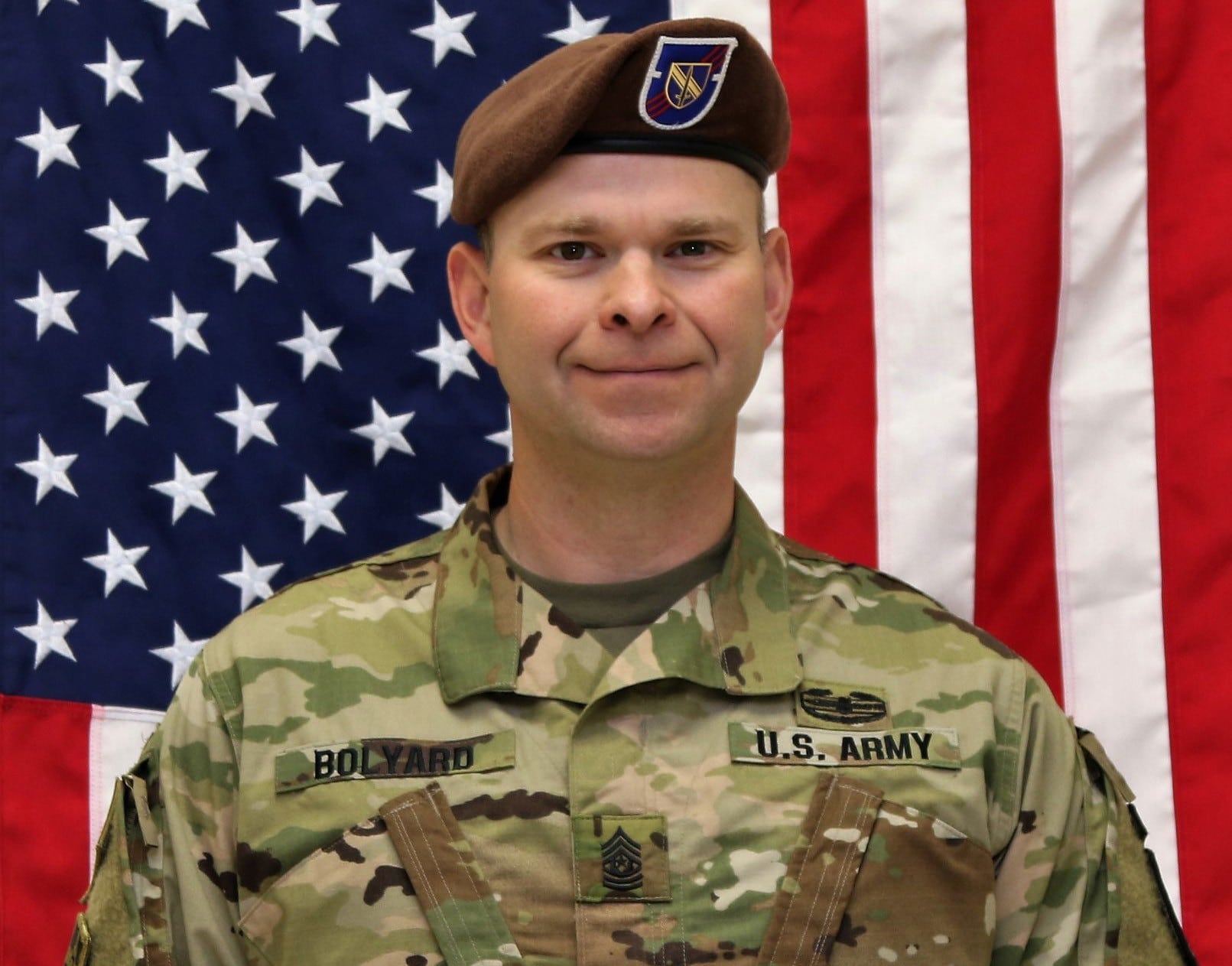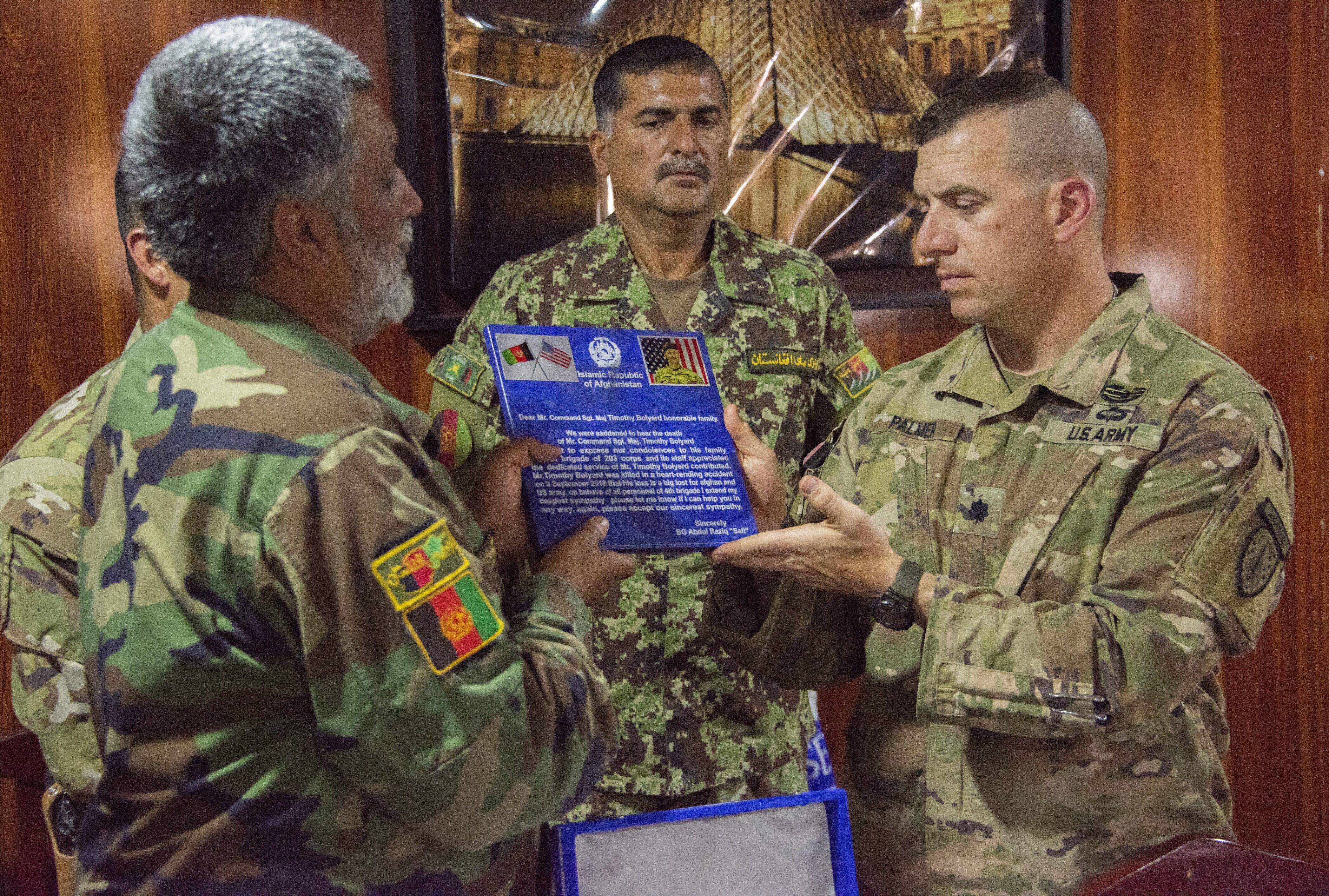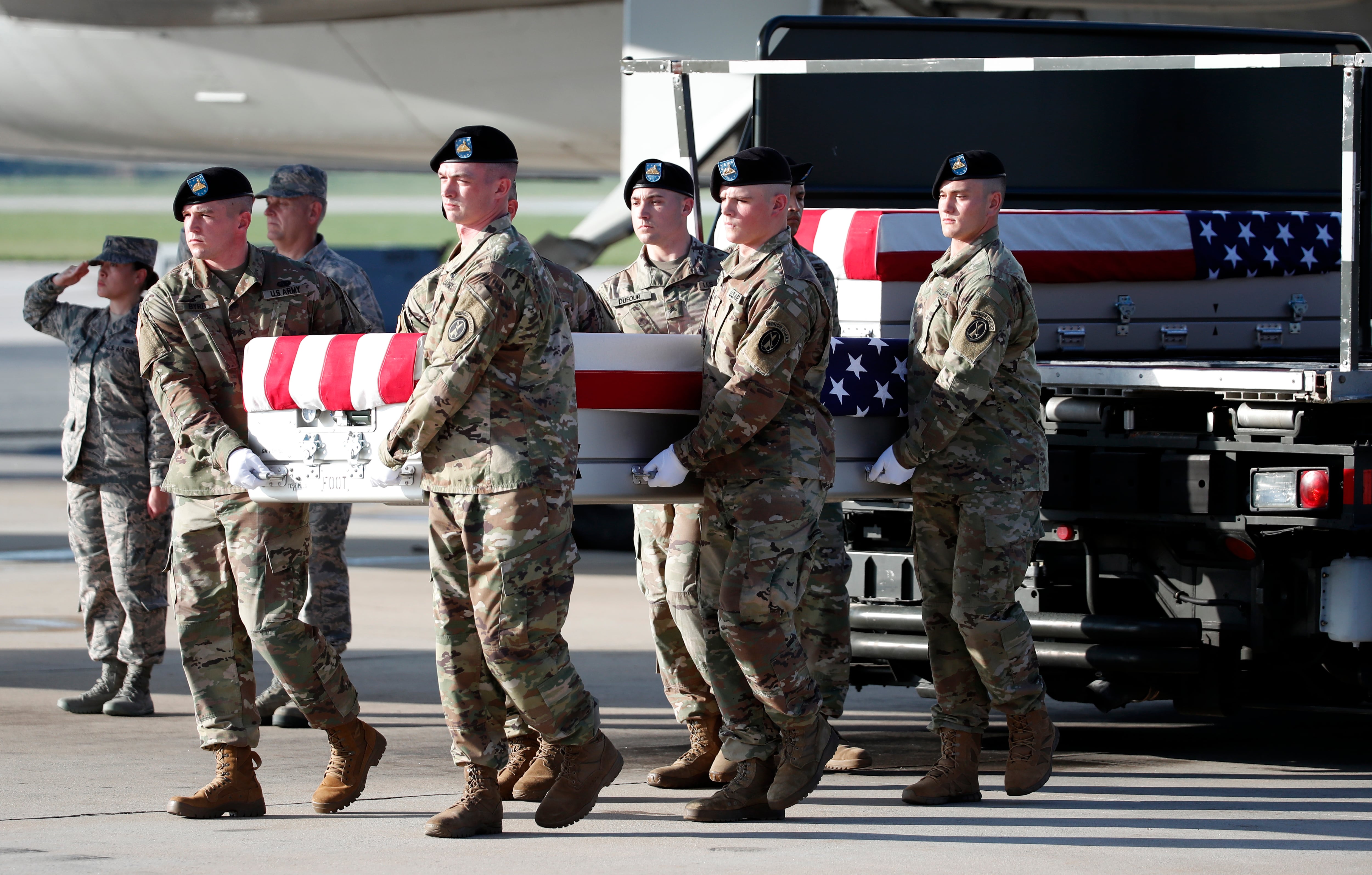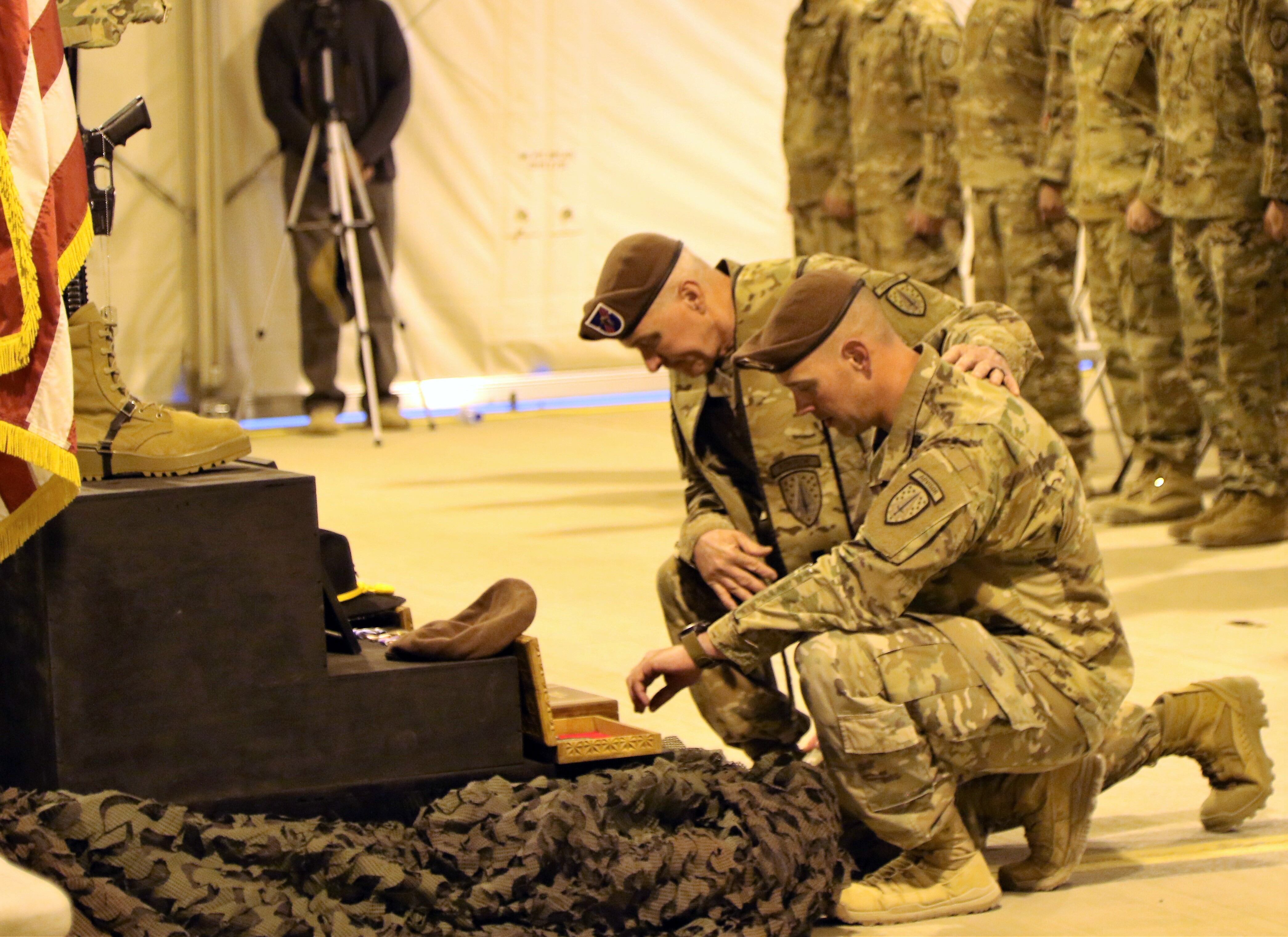Afghan National Police did not typically attend the meetings, or shuras, between U.S. troops and Afghan soldiers on Camp Maiwand in Logar province.
But the police forces, known as ANP, were necessary on Sept. 3, 2018. Elections were close at hand and the ANP would play a large role in provincial security as insurgents attempted to undermine the country’s already fragile electoral process.
Brig. Gen. Muhammad Raziq, an Afghan Army commander at Camp Maiwand, invited ANP leaders and U.S. advisers to a 10 a.m. shura in his office to discuss election security. The Afghan leaders brought personal security details with them, increasing the number of attendees beyond what was normal.
That set the stage for an insider attack, immediately following the shura, that claimed the life of Army Command Sgt. Maj. Timothy Bolyard.
Security details are “strictly forbidden from carrying weapons to shura when U.S. advisers are present,” according to an Afghan counter-intelligence commander cited in an investigation into the green-on-blue attack. However, Raziq allowed the men “to enter with their weapons.”
The investigation document, obtained by Army Times through a Freedom of Information Act request, implicated and named four ANP officers in the fatal shooting. Officials from U.S. Forces-Afghanistan said they had nothing to add to the report when asked to comment.
The ANP security detail never went into Raziq’s office, where the shura took place. They remained outside on a concrete pad by their vehicles. In the office, only the Americans were armed, according to the investigation.
The U.S. troops were from the 1st Security Force Assistance Brigade, out of Fort Benning, Georgia. The unit was the Army’s first SFAB to activate and deploy abroad to train foreign militaries. Bolyard, a six-time Bronze Star recipient and veteran of seven deployments, was the top enlisted soldier for 1st SFAB’s 3rd Squadron. The unit was posted to a U.S.-controlled base adjacent to Camp Maiwand called AP CASA.
No body armor on U.S. advisers
The shura concluded without issue and the attendees broke for lunch, with the exception of the ANP, who said they planned to return to their own base. Not long afterward, Bolyard and several others who had stopped by the latrines made their way along a narrow path to the chow hall, surrounded on both sides by shipping containers and 12-foot-tall concrete barriers.
Sixty meters from the dining facility’s entrance, an AK-47 and PK machine gun erupted behind them. The soldiers dashed for cover in the narrow passage, but Bolyard and another American were hit in the melee.
Witnesses saw Bolyard draw his pistol, spin around toward the shura site where the gunfire originated, and then turn back toward cover before falling to the ground. He died a little more than an hour later from a single gunshot wound to his back.
The 42-year-old soldier, like other advisers at the shura, wasn’t wearing body armor. It was a decision made by the squadron after discussions with 1st SFAB’s commander, Brig. Gen. Scott A. Jackson.
There had been no history of insider attacks at Camp Maiwand, they reasoned, and not wearing full kit symbolized the building of trust between the U.S. advisers and their Afghan partners, according to the investigation.

During the shura, the ANP security detail had remained outside Raziq’s office by their gun trucks while their leadership entered with the U.S. and Afghan soldiers.
A trail of U.S. troops stood guard in the hallways leading from the office back outside. Those Americans did wear body armor, as they were providing security. But soldiers said after the attack that nothing appeared suspicious as they scanned their sectors during the nearly two-hour shura.
“No witnesses reported any tension or arguments,” the investigation reads. Afghan soldiers and police outside talked on cell phones. Some inside Raziq’s office joked about their equipment and security shortfalls, banter that an investigator noted was “within cultural norms.”
None of the U.S. troops were able to identify the shooter during the attack, only knowing that the fire had come from the direction of the shura they had just left. The attack seemed to end as abruptly as it started.
“U.S. forces stated that both the [Afghan soldiers] and ANP were mostly standing around and did nothing to help during the immediate aftermath,” according to the investigation.
The Americans secured their area and began tending to Bolyard’s wounds, identifying a possible spinal injury and a collapsed lung. They sealed the entrance wound but could find no exit.
The team radioed for a quick reaction force and made the roughly four-minute trek back to their side of Camp Maiwand. A surgical team there attempted to stop Bolyard’s bleeding and restart his heart, to no avail. Bolyard was declared deceased a little more than an hour after being shot.
The Americans locked down their base to ensure no one could enter or exit and Raziq agreed to do the same.
The shooting and the getaway
Just before 7 p.m., Raziq called the Americans to inform them that he had captured four ANP officers who were the alleged perpetrators of the attack. Three weapons, five cell phones and six SIM cards were recovered and turned over.
Witnesses agreed that shots had come in the direction of the ANP officers located outside Raziq’s office. Only one Afghan soldier, Mohammed Sabir, came forward as an eyewitness to the actual shooting.
Sabir recounted seeing an ANP officer named Javed Noorduddin fire about four rounds from his AK-47 at the U.S. advisers. Another ANP officer, Mir Wali, followed by firing two bursts of roughly six rounds from a PK machine gun.
Two other ANP officers, Atiq Ullah and Mohammed Farooq, were suspected accomplices. They were accused of driving the car in which the shooters made their escape after they opened fire.

The four men successfully departed Camp Maiwand and made their way to a nearby compound operated by the National Directorate of Security — the Afghan government’s primary intelligence agency. But the accounts of how the ANP officers were ultimately captured are disputed in the investigation.
Most of the Afghan National Army leaders said that they did not know if the ANP officers left Camp Maiwand, because they were too busy dealing with the aftermath of the attack. One leader claimed that Afghan soldiers intercepted the perpetrators and escorted them back to Camp Maiwand to ensure they did not escape.
Raziq claimed that the perpetrators were not allowed to depart Camp Maiwand, but all four of them, as well as other Afghan Army soldiers, stated that the ANP officers left the base.
What motive, if any, was ultimately discovered was not shared in the investigation. Nor did the heavily redacted document disclose what punishment was meted out to the Afghan attackers. Officials from U.S. Forces-Afghanistan declined to elaborate on the investigation’s findings.
All the recommendations were also redacted, except for one bullet point instructing that the document be shared with the Military Adviser Training Academy at Fort Benning to help future SFAB soldiers, many of whom may still be destined for Afghanistan missions.
Advising mission goes on
All the key Afghan leaders present during the shura agreed to cooperate with the investigation. An NDS chief of staff who had attended the shura and several other Afghan Army leaders were interviewed by the Americans, and the weapons used in the attack were turned over for ballistics analysis and forensic testing.
One month after the fatal attack, Raziq expressed his remorse over the incident during a shared, relationship-mending meal on the American camp.
“That was our mistake and we accept that,” Raziq said through an interpreter during the meal, which was chronicled by U.S. soldiers. “I would have preferred to be killed myself.”

Raziq presented a plaque commemorating the fallen sergeant major, and handed over an Afghan rug, asking that it be delivered to Bolyard’s family.
“Since the beginning of this Afghan Army, I’ve been working with the Americans shoulder-to-shoulder,” Raziq said. “Today, whatever we have within the Afghan Army, it’s all because of the hard work of Americans and their support.”
The loss of Bolyard was not the first insider attack that 1st SFAB suffered during their deployment to Afghanistan. An incident near Tarin Kowt Airfield, in Uruzgan province, two months earlier left one soldier dead and two others wounded. The fallen soldier had been an infantryman serving as security for the SFAB mission.
Since the return of 1st SFAB, subsequent units have continued to deploy to Afghanistan. The 2nd SFAB rotated to the country in spring 2019, and the 3rd SFAB replaced them this winter. Currently, the 4th SFAB is training in preparation to deploy there later this summer.
Maj. Christina Wright, a spokeswoman for the division-level command overseeing the Army’s SFABs, said U.S. advisers “constantly review and improve” force protection procedures and “apply valuable lessons learned from our previous deployments.”
“Even though two years have passed, we still grieve the loss of CSM Bolyard,” Wright said in a statement. “It is our highest priority to ensure our force-protection procedures in the regions where we advise are appropriate for the level of potential risks associated with the missions we conduct.”
Kyle Rempfer was an editor and reporter who has covered combat operations, criminal cases, foreign military assistance and training accidents. Before entering journalism, Kyle served in U.S. Air Force Special Tactics and deployed in 2014 to Paktika Province, Afghanistan, and Baghdad, Iraq.





